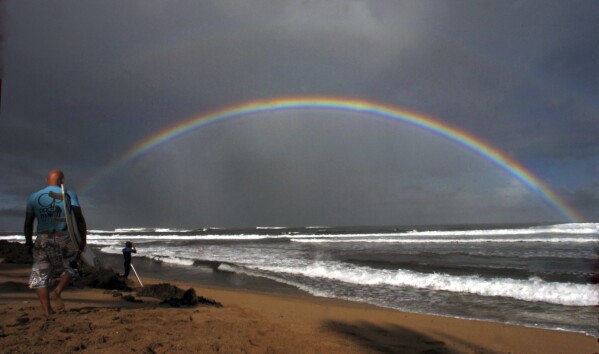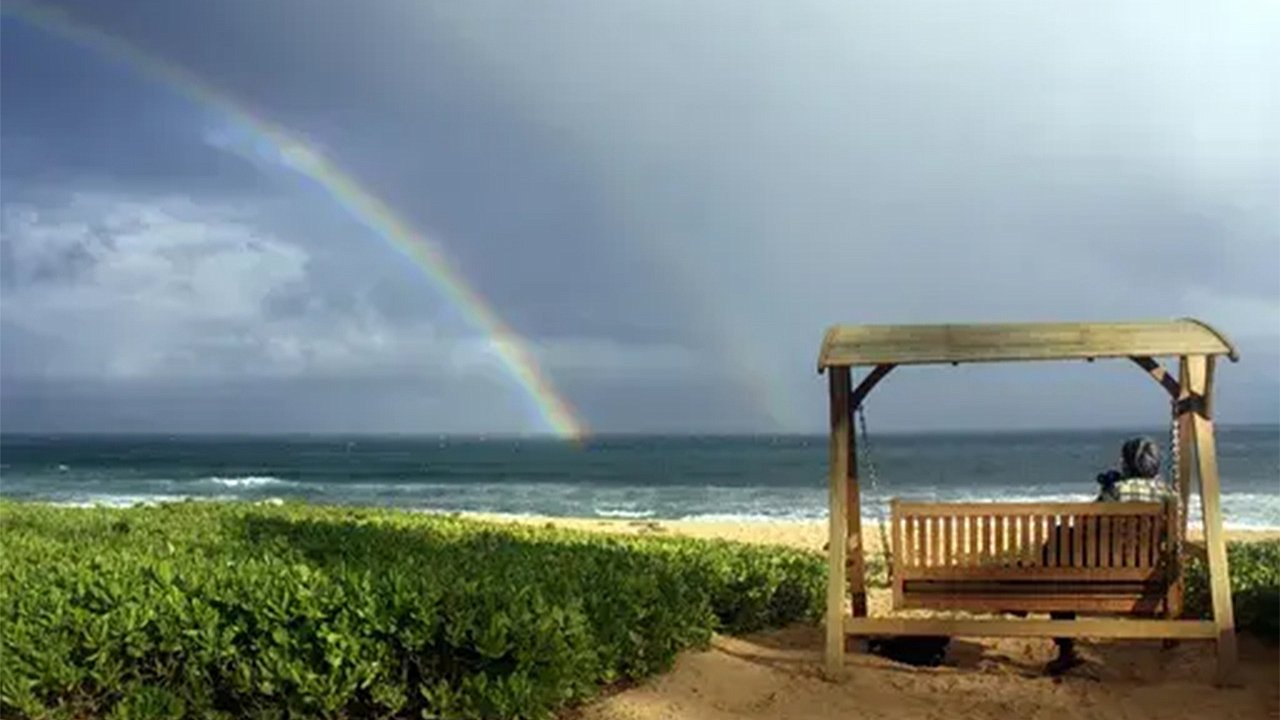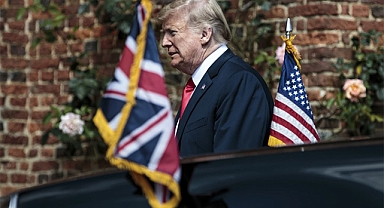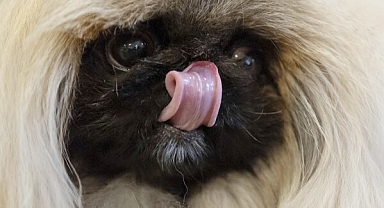Hawaii: The rainbow capital of the WorldHawaii’s combination of sunny days, short rain showers, and clean air creates one of the best environments on Earth for spotting rainbows. The frequent sightings of rainbows in the islands have earned Hawaii the title of the “rainbow capital of the world,” a term coined by a University of Hawaii professor.During Hawaii’s winter rainy season, which lasts from October to April, the chances of seeing a rainbow are higher than usual. The islands' clear air and trade winds, which bring in light showers, ensure that the sky is often bright enough for a rainbow to form. The rainbow's colors emerge when sunlight refracts through raindrops, with the best views appearing when it is both sunny and rainy. These rainbows can often be seen opposite the sun, appearing larger in the early morning or late afternoon when the sun is lower on the horizon.The prevalence of rainbows has made them an iconic symbol of island life. The imagery of rainbows is so ubiquitous in Hawaii that you’ll find it adorning buildings, public buses, and even vehicle license plates. Hawaii's sports teams are also named after rainbows, with the men’s teams known as the Rainbow Warriors and the women’s teams as the Rainbow Wahine.The rainbow’s symbolism goes beyond just its beauty. Liane Usher, president of the Children’s Discovery Center in Honolulu, says that for her, rainbows represent hope and new beginnings. “I can’t ever help but smile whenever I see a rainbow after the rain,” she shared. The state’s clean air, combined with the unique weather patterns, makes it the ideal location for the best rainbows. Where Can You Find Rainbows?Rainbows are common in Hawaii, especially when it's both sunny and raining at the same time. They appear opposite the sun, and the best time to spot them is when the sun is low on the horizon in the early morning or late afternoon. Hawaii’s trade winds help bring small, frequent showers, which allow blue skies to break through and light up the raindrops, creating vibrant rainbows.The clean air in Hawaii also contributes to the clarity of these rainbows. Unlike many places where pollutants and dust particles obscure visibility, Hawaii’s fresh air offers near-perfect conditions. For an added boost, the rainy season, which runs from October through April, increases the frequency of rainbows.
Where Can You Find Rainbows?Rainbows are common in Hawaii, especially when it's both sunny and raining at the same time. They appear opposite the sun, and the best time to spot them is when the sun is low on the horizon in the early morning or late afternoon. Hawaii’s trade winds help bring small, frequent showers, which allow blue skies to break through and light up the raindrops, creating vibrant rainbows.The clean air in Hawaii also contributes to the clarity of these rainbows. Unlike many places where pollutants and dust particles obscure visibility, Hawaii’s fresh air offers near-perfect conditions. For an added boost, the rainy season, which runs from October through April, increases the frequency of rainbows. Rainbows in Hawaiian CultureIn Native Hawaiian culture, rainbows are much more than a visual phenomenon. They represent divine or supernatural power and are strongly linked to Kāne, one of Hawaii’s key gods. The appearance of a rainbow in Hawaiian folklore often signals the presence of a powerful or spiritual being. In one ancient story, a rainbow appears above the home of a princess for several days, signaling the presence of an important supernatural force.For cultural practitioner Hinaleimoana Wong-Kalu, a rainbow serves as a message from the “aumakua,” or a family or personal god. These divine ancestors, Wong-Kalu explains, sometimes use rainbows to communicate their protection and love for their living relatives.A Symbol of Island Life and SportsRainbows have been a part of Hawaii’s identity for nearly a century. The nickname for Hawaii’s sports teams, “Rainbows,” began in 1924 after a rainbow appeared during a football game between Hawaii and the Oregon Aggies. The rainbow marked a turning point in the game when Hawaii scored shortly after its appearance. The association was so strong that the sports teams adopted the name “Rainbows,” a tradition that continued for decades.However, in 2000, the name was briefly dropped by the football team due to concerns about its association with the LGBTQ+ community. It wasn’t until 2013 that the name was restored, reflecting the strong connection between rainbows and the island’s cultural identity.How Climate Change Could Affect RainbowsWhile rainbows are expected to remain a staple in Hawaii for the foreseeable future, experts suggest that climate change could have an impact. According to Kimberly Carlson, a researcher studying the effects of climate change, some areas might see fewer rainbows due to shifts in precipitation patterns. For instance, places that receive more rain instead of snow might experience an increase in rainbows. On the other hand, Hawaii’s arid, leeward sides, especially Maui and the Big Island, could see fewer rainbows as longer dry spells become more common.Despite these challenges, rainbows will continue to be an integral part of Hawaii’s culture and daily life. As atmospheric science professor Steven Businger notes, “Rainbows are a cultural touchstone for us. They cause us to stand still and for a moment, forget about the past and the future.”
Rainbows in Hawaiian CultureIn Native Hawaiian culture, rainbows are much more than a visual phenomenon. They represent divine or supernatural power and are strongly linked to Kāne, one of Hawaii’s key gods. The appearance of a rainbow in Hawaiian folklore often signals the presence of a powerful or spiritual being. In one ancient story, a rainbow appears above the home of a princess for several days, signaling the presence of an important supernatural force.For cultural practitioner Hinaleimoana Wong-Kalu, a rainbow serves as a message from the “aumakua,” or a family or personal god. These divine ancestors, Wong-Kalu explains, sometimes use rainbows to communicate their protection and love for their living relatives.A Symbol of Island Life and SportsRainbows have been a part of Hawaii’s identity for nearly a century. The nickname for Hawaii’s sports teams, “Rainbows,” began in 1924 after a rainbow appeared during a football game between Hawaii and the Oregon Aggies. The rainbow marked a turning point in the game when Hawaii scored shortly after its appearance. The association was so strong that the sports teams adopted the name “Rainbows,” a tradition that continued for decades.However, in 2000, the name was briefly dropped by the football team due to concerns about its association with the LGBTQ+ community. It wasn’t until 2013 that the name was restored, reflecting the strong connection between rainbows and the island’s cultural identity.How Climate Change Could Affect RainbowsWhile rainbows are expected to remain a staple in Hawaii for the foreseeable future, experts suggest that climate change could have an impact. According to Kimberly Carlson, a researcher studying the effects of climate change, some areas might see fewer rainbows due to shifts in precipitation patterns. For instance, places that receive more rain instead of snow might experience an increase in rainbows. On the other hand, Hawaii’s arid, leeward sides, especially Maui and the Big Island, could see fewer rainbows as longer dry spells become more common.Despite these challenges, rainbows will continue to be an integral part of Hawaii’s culture and daily life. As atmospheric science professor Steven Businger notes, “Rainbows are a cultural touchstone for us. They cause us to stand still and for a moment, forget about the past and the future.”
 Where Can You Find Rainbows?Rainbows are common in Hawaii, especially when it's both sunny and raining at the same time. They appear opposite the sun, and the best time to spot them is when the sun is low on the horizon in the early morning or late afternoon. Hawaii’s trade winds help bring small, frequent showers, which allow blue skies to break through and light up the raindrops, creating vibrant rainbows.The clean air in Hawaii also contributes to the clarity of these rainbows. Unlike many places where pollutants and dust particles obscure visibility, Hawaii’s fresh air offers near-perfect conditions. For an added boost, the rainy season, which runs from October through April, increases the frequency of rainbows.
Where Can You Find Rainbows?Rainbows are common in Hawaii, especially when it's both sunny and raining at the same time. They appear opposite the sun, and the best time to spot them is when the sun is low on the horizon in the early morning or late afternoon. Hawaii’s trade winds help bring small, frequent showers, which allow blue skies to break through and light up the raindrops, creating vibrant rainbows.The clean air in Hawaii also contributes to the clarity of these rainbows. Unlike many places where pollutants and dust particles obscure visibility, Hawaii’s fresh air offers near-perfect conditions. For an added boost, the rainy season, which runs from October through April, increases the frequency of rainbows. Rainbows in Hawaiian CultureIn Native Hawaiian culture, rainbows are much more than a visual phenomenon. They represent divine or supernatural power and are strongly linked to Kāne, one of Hawaii’s key gods. The appearance of a rainbow in Hawaiian folklore often signals the presence of a powerful or spiritual being. In one ancient story, a rainbow appears above the home of a princess for several days, signaling the presence of an important supernatural force.For cultural practitioner Hinaleimoana Wong-Kalu, a rainbow serves as a message from the “aumakua,” or a family or personal god. These divine ancestors, Wong-Kalu explains, sometimes use rainbows to communicate their protection and love for their living relatives.A Symbol of Island Life and SportsRainbows have been a part of Hawaii’s identity for nearly a century. The nickname for Hawaii’s sports teams, “Rainbows,” began in 1924 after a rainbow appeared during a football game between Hawaii and the Oregon Aggies. The rainbow marked a turning point in the game when Hawaii scored shortly after its appearance. The association was so strong that the sports teams adopted the name “Rainbows,” a tradition that continued for decades.However, in 2000, the name was briefly dropped by the football team due to concerns about its association with the LGBTQ+ community. It wasn’t until 2013 that the name was restored, reflecting the strong connection between rainbows and the island’s cultural identity.How Climate Change Could Affect RainbowsWhile rainbows are expected to remain a staple in Hawaii for the foreseeable future, experts suggest that climate change could have an impact. According to Kimberly Carlson, a researcher studying the effects of climate change, some areas might see fewer rainbows due to shifts in precipitation patterns. For instance, places that receive more rain instead of snow might experience an increase in rainbows. On the other hand, Hawaii’s arid, leeward sides, especially Maui and the Big Island, could see fewer rainbows as longer dry spells become more common.Despite these challenges, rainbows will continue to be an integral part of Hawaii’s culture and daily life. As atmospheric science professor Steven Businger notes, “Rainbows are a cultural touchstone for us. They cause us to stand still and for a moment, forget about the past and the future.”
Rainbows in Hawaiian CultureIn Native Hawaiian culture, rainbows are much more than a visual phenomenon. They represent divine or supernatural power and are strongly linked to Kāne, one of Hawaii’s key gods. The appearance of a rainbow in Hawaiian folklore often signals the presence of a powerful or spiritual being. In one ancient story, a rainbow appears above the home of a princess for several days, signaling the presence of an important supernatural force.For cultural practitioner Hinaleimoana Wong-Kalu, a rainbow serves as a message from the “aumakua,” or a family or personal god. These divine ancestors, Wong-Kalu explains, sometimes use rainbows to communicate their protection and love for their living relatives.A Symbol of Island Life and SportsRainbows have been a part of Hawaii’s identity for nearly a century. The nickname for Hawaii’s sports teams, “Rainbows,” began in 1924 after a rainbow appeared during a football game between Hawaii and the Oregon Aggies. The rainbow marked a turning point in the game when Hawaii scored shortly after its appearance. The association was so strong that the sports teams adopted the name “Rainbows,” a tradition that continued for decades.However, in 2000, the name was briefly dropped by the football team due to concerns about its association with the LGBTQ+ community. It wasn’t until 2013 that the name was restored, reflecting the strong connection between rainbows and the island’s cultural identity.How Climate Change Could Affect RainbowsWhile rainbows are expected to remain a staple in Hawaii for the foreseeable future, experts suggest that climate change could have an impact. According to Kimberly Carlson, a researcher studying the effects of climate change, some areas might see fewer rainbows due to shifts in precipitation patterns. For instance, places that receive more rain instead of snow might experience an increase in rainbows. On the other hand, Hawaii’s arid, leeward sides, especially Maui and the Big Island, could see fewer rainbows as longer dry spells become more common.Despite these challenges, rainbows will continue to be an integral part of Hawaii’s culture and daily life. As atmospheric science professor Steven Businger notes, “Rainbows are a cultural touchstone for us. They cause us to stand still and for a moment, forget about the past and the future.” 




